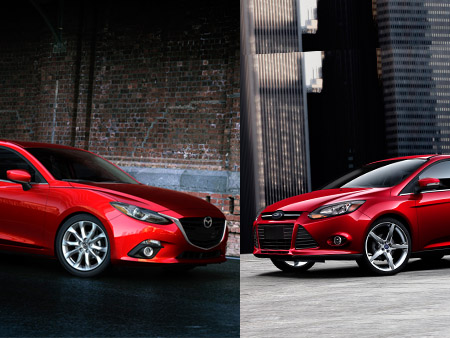Comparo: 2014 Ford Focus 5-door Titanium vs. 2014 Mazda3 Sport GT
Story by John LeBlanc
Welcome to the heart of the Canadian new car market: the compact class. While the profits are thin for their makers, compact cars perennially sit at the top of the sales charts. And such fierce competition has brought some outstanding value to new car buyers. Take for instance this pair of front-wheel-drive, five-passenger, four-door compact hatchback combatants.
By offering big car features and European-style road manners, the Ford Focus has been a favourite of car critics since the latest generation was introduced for 2011. But now we have the all-new Mazda3, seemingly created to one-up the Ford. So which one is this compact critic’s choice?
The base model Mazda3 Sport GS starts at $18,690 (all prices include freight and pre-delivery inspection fees). But for $28,550, my topline GT tester came with many of the features normally associated with full-size luxury cars (like a voice-activated navigation system and head-up display) and matches up well against the equally luxurious $29,964 Ford Focus Titanium.
While these two compacts share a similar feature set, the ergonomic design and build quality of the Mazda’s interior is reason enough to pick it over the Ford. From its large, iPad-like central screen (with its easy-to-use and high-def graphics) to its console-mounted dial controller (that looks like it was snatched from an Audi), not to mention the use of soft-touch materials, the Mazda3 Sport GT’s cabin is more functional to use and a nicer place to be than the Focus Titanium. Plus, rear seat passengers in the Mazda will find more legroom than in the Ford.
While lesser Mazda3s are saddled with an anemic, 155 horsepower and 150 pound-feet of torque 2.0-litre four-cylinder gas engine, the upscale GT models get a larger, 2.5L unit with 19 more hp and a substantial 19 more lb-ft. Mated to a mandatory six-speed automatic, the Mazda is quicker from zero to 100 kilometres per hour (8.1 seconds, versus 8.5) than the less powerful Ford, but manages to score identical fuel economy estimates (7.5 litres per 100 km city; 5.1 highway).
As functional, fast and frugal as the Mazda compact hatch is, it’s also a small car that driving enthusiasts can enjoy. Weighing in at 1,335 kilograms (66 less than the Focus), the Mazda gets a head start on the physics of cornering. Combined with steering that is accurate and natural in feel, the Mazda3 Sport GT reacts quicker to driver inputs than the Focus Titanium. And the Mazda’s shock tuning delivers a flatter cornering attitude while maintaining a comfortable ride.
Of course, no car is perfect. So if there is one flaw in the Mazda3 Sport GT’s makeup, it would be the lack of a manual gearbox with the larger mill. For a brand that caters to enthusiasts, it’s an obvious deficit.
As you can tell, this small car critic likes the new 2014 Mazda3 Sport GT — a lot. Not only does it replace the Focus as my favourite, all-around compact, it should give pause to buyers considering the new wave of so-called premium compacts with much higher price tags.
SECOND PLACE: 2014 Ford Focus 5-door Titanium
Don’t let the Ford’s runner-up status fool you. It simply got beat by a better compact car. But that doesn’t mean the Focus Titanium doesn’t still rank as one of my favourite small cars to drive.
While a product of the previous Focus platform that was also shared with Mazda and Volvo, this third-generation model’s body structure is as solid as frozen Canadian tundra. So even though the Ford of Europe-designed suspension is comparatively stiff, there are nary any rattles or squeaks emanating from the Focus Titanium’s cabin. And although it weighs more than the Mazda, the Ford hatch’s steering offers excellent off-centre feel. Plus its electronic stability control system does a good job keeping the hatchback balanced in fast corners while not making its actions known to the driver.
One reason I’d opt for the Focus Titanium over the Mazda3 Sport GT is the availability of a five-speed manual transmission. Not only do you save $1,750 dollars, but you also avoid the Ford’s unrefined dual-clutch automatic. Despite the pair of clutches, the autobox seems tuned more for fuel economy than blasting through back roads. And the autobox doesn’t do the Ford’s weaker, 160 hp and 146 2.0 L four-cylinder gas engine any favours. On its own, the Focus’s four doesn’t sound as refined or as quiet as the Mazda3’s larger powerplant.
While feature-laden in Titanium trim and relatively well built, I’ve never been a fan of the busy interior design and fuzzy functionality of this generation of Focus. Compared to the easy-to-figure-out Mazda cockpit, the buttons and controls for the Focus can take some getting used to. And the less said about Ford’s troublesome Sync voice-activated technology, the better.
For as little as $17,864, you can get a 2014 Focus SE hatch. It comes with the same four-cylinder gas engine as the upper crust Titanium, a five-speed manual transmission and a lot less kit. But to match the already-well-equipped Mazda3 Sport GT, you have to add the aforementioned automatic, $1,200 sunroof, $800 navigation system and $400 handling package, which gives the Mazda a $1,414 price advantage.
The availability of a manual gearbox may drive some enthusiasts to a Ford store. But if that’s not your particular driving fetish, feel free to agree with this small car critic and go test drive the 2014 Mazda3 Sport GT.
Comments
2 Responses to “Comparo: 2014 Ford Focus 5-door Titanium vs. 2014 Mazda3 Sport GT”










![[del.icio.us]](https://www.straight-six.com/wp-content/plugins/bookmarkify/delicious.png)
![[Digg]](https://www.straight-six.com/wp-content/plugins/bookmarkify/digg.png)
![[Facebook]](https://www.straight-six.com/wp-content/plugins/bookmarkify/facebook.png)
![[Google]](https://www.straight-six.com/wp-content/plugins/bookmarkify/google.png)
![[Reddit]](https://www.straight-six.com/wp-content/plugins/bookmarkify/reddit.png)
![[StumbleUpon]](https://www.straight-six.com/wp-content/plugins/bookmarkify/stumbleupon.png)
![[Twitter]](https://www.straight-six.com/wp-content/plugins/bookmarkify/twitter.png)
![[Email]](https://www.straight-six.com/wp-content/plugins/bookmarkify/email.png)
January 25th, 2014 @ 12:16 am
[…] Comparo: 2014 Ford Focus 5-door Titanium vs. 2014 Mazda3 Sport … […]
February 4th, 2014 @ 4:53 pm
[…] Comparo: 2014 Ford focus 5-door Titanium vs. 2014 Mazda3 recreation … […]